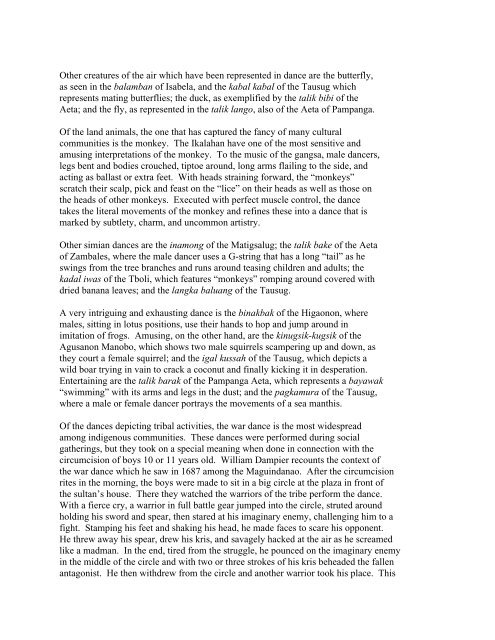THE ETHNIC TRADITION IN PHILIPPINE THEATER In the ...
THE ETHNIC TRADITION IN PHILIPPINE THEATER In the ...
THE ETHNIC TRADITION IN PHILIPPINE THEATER In the ...
You also want an ePaper? Increase the reach of your titles
YUMPU automatically turns print PDFs into web optimized ePapers that Google loves.
O<strong>the</strong>r creatures of <strong>the</strong> air which have been represented in dance are <strong>the</strong> butterfly,<br />
as seen in <strong>the</strong> balamban of Isabela, and <strong>the</strong> kabal kabal of <strong>the</strong> Tausug which<br />
represents mating butterflies; <strong>the</strong> duck, as exemplified by <strong>the</strong> talik bibi of <strong>the</strong><br />
Aeta; and <strong>the</strong> fly, as represented in <strong>the</strong> talik lango, also of <strong>the</strong> Aeta of Pampanga.<br />
Of <strong>the</strong> land animals, <strong>the</strong> one that has captured <strong>the</strong> fancy of many cultural<br />
communities is <strong>the</strong> monkey. The Ikalahan have one of <strong>the</strong> most sensitive and<br />
amusing interpretations of <strong>the</strong> monkey. To <strong>the</strong> music of <strong>the</strong> gangsa, male dancers,<br />
legs bent and bodies crouched, tiptoe around, long arms flailing to <strong>the</strong> side, and<br />
acting as ballast or extra feet. With heads straining forward, <strong>the</strong> “monkeys”<br />
scratch <strong>the</strong>ir scalp, pick and feast on <strong>the</strong> “lice” on <strong>the</strong>ir heads as well as those on<br />
<strong>the</strong> heads of o<strong>the</strong>r monkeys. Executed with perfect muscle control, <strong>the</strong> dance<br />
takes <strong>the</strong> literal movements of <strong>the</strong> monkey and refines <strong>the</strong>se into a dance that is<br />
marked by subtlety, charm, and uncommon artistry.<br />
O<strong>the</strong>r simian dances are <strong>the</strong> inamong of <strong>the</strong> Matigsalug; <strong>the</strong> talik bake of <strong>the</strong> Aeta<br />
of Zambales, where <strong>the</strong> male dancer uses a G-string that has a long “tail” as he<br />
swings from <strong>the</strong> tree branches and runs around teasing children and adults; <strong>the</strong><br />
kadal iwas of <strong>the</strong> Tboli, which features “monkeys” romping around covered with<br />
dried banana leaves; and <strong>the</strong> langka baluang of <strong>the</strong> Tausug.<br />
A very intriguing and exhausting dance is <strong>the</strong> binakbak of <strong>the</strong> Higaonon, where<br />
males, sitting in lotus positions, use <strong>the</strong>ir hands to hop and jump around in<br />
imitation of frogs. Amusing, on <strong>the</strong> o<strong>the</strong>r hand, are <strong>the</strong> kinugsik-kugsik of <strong>the</strong><br />
Agusanon Manobo, which shows two male squirrels scampering up and down, as<br />
<strong>the</strong>y court a female squirrel; and <strong>the</strong> igal kussah of <strong>the</strong> Tausug, which depicts a<br />
wild boar trying in vain to crack a coconut and finally kicking it in desperation.<br />
Entertaining are <strong>the</strong> talik barak of <strong>the</strong> Pampanga Aeta, which represents a bayawak<br />
“swimming” with its arms and legs in <strong>the</strong> dust; and <strong>the</strong> pagkamura of <strong>the</strong> Tausug,<br />
where a male or female dancer portrays <strong>the</strong> movements of a sea manthis.<br />
Of <strong>the</strong> dances depicting tribal activities, <strong>the</strong> war dance is <strong>the</strong> most widespread<br />
among indigenous communities. These dances were performed during social<br />
ga<strong>the</strong>rings, but <strong>the</strong>y took on a special meaning when done in connection with <strong>the</strong><br />
circumcision of boys 10 or 11 years old. William Dampier recounts <strong>the</strong> context of<br />
<strong>the</strong> war dance which he saw in 1687 among <strong>the</strong> Maguindanao. After <strong>the</strong> circumcision<br />
rites in <strong>the</strong> morning, <strong>the</strong> boys were made to sit in a big circle at <strong>the</strong> plaza in front of<br />
<strong>the</strong> sultan’s house. There <strong>the</strong>y watched <strong>the</strong> warriors of <strong>the</strong> tribe perform <strong>the</strong> dance.<br />
With a fierce cry, a warrior in full battle gear jumped into <strong>the</strong> circle, struted around<br />
holding his sword and spear, <strong>the</strong>n stared at his imaginary enemy, challenging him to a<br />
fight. Stamping his feet and shaking his head, he made faces to scare his opponent.<br />
He threw away his spear, drew his kris, and savagely hacked at <strong>the</strong> air as he screamed<br />
like a madman. <strong>In</strong> <strong>the</strong> end, tired from <strong>the</strong> struggle, he pounced on <strong>the</strong> imaginary enemy<br />
in <strong>the</strong> middle of <strong>the</strong> circle and with two or three strokes of his kris beheaded <strong>the</strong> fallen<br />
antagonist. He <strong>the</strong>n withdrew from <strong>the</strong> circle and ano<strong>the</strong>r warrior took his place. This
















